Extrinsic Evidence, or Eight Corners? Texas Court Sheds Light on Determining the Duty to Defend
December 18, 2022 —
Nathan A. Cazier - Payne & FearsLast year, the Texas Supreme Court adopted a narrow exception to the state’s eight-corners rule, and allowed the consideration of extrinsic evidence to determine the duty to defend. The exception arguably raised more questions than it resolved. Last month, a Texas federal court answered some of these questions by rejecting an insurer’s attempt to introduce extrinsic evidence under the newly minted exception.
Texas permits few, if any, deviations from its eight-corners rule, which determines an insurer’s duty to defend by only considering the operative pleading and the terms of the policy, without any regard to extrinsic evidence or facts. This protects policyholders by erring on the side of defending claims, even if coverage is questionable. In Monroe Guar. Ins. Co. v. Bitco Gen. Ins. Corp., 640 S.W.3d 195, 199 (Tex. 2022) (“Monroe”), the Texas Supreme Court adopted an exception to the eight-corners rule, holding that extrinsic evidence may be considered when an “information gap” between the pleading and the policy makes it impossible to determine coverage, but only in limited scenarios where the extrinsic evidence (1) goes solely to an issue of coverage and does not overlap with the merits of liability, (2) does not contradict facts alleged in the pleading, and (3) conclusively establishes the coverage fact to be proved.
Read the court decisionRead the full story...Reprinted courtesy of
Nathan A. Cazier, Payne & FearsMr. Cazier may be contacted at
nac@paynefears.com
White Collar Overtime Regulations Temporarily Blocked
November 23, 2016 —
George Morrison – White and Williams LLPOn November 22, 2016, a Texas federal court issued a preliminary injunction that temporarily blocks the U.S. Department of Labor (DOL) from implementing and enforcing its revised white collar overtime regulations nationwide. The regulations were to take effect on December 1, 2016. For background on the DOL's Final Rule, see our alert, DOL Issues Final Rule Amending Overtime Exemptions Under FLSA.
The decision was issued in a consolidated set of cases brought by 21 states and several business organizations. The cases challenge the changes to 29 C.F.R. Part 541, which defines the standards for evaluating whether employees are exempt executive, administrative, and/or professional employees. Under the current regulations, the minimum salary requirement for these exemptions is $455 per week. Under the revised regulations, the minimum salary would more than double to $913 per week. The Texas court found that the plaintiffs’ challenge to the final regulations has a substantial likelihood of success and that the plaintiffs have shown that they would be irreparably harmed if the rule was not enjoined.
Read the court decisionRead the full story...Reprinted courtesy of
George Morrison, White and Williams LLPMr. Morrison may be contacted at
morrisong@whiteandwilliams.com
Re-Thinking the One-Sided Contract: Considerations for a More Balanced Approach to Contracting
November 21, 2022 —
William Underwood - ConsensusDocsConstruction projects can be inherently risky – often there are multiple parties (owners, architects, engineers, contractors, subcontractors, consultants, vendors, government officials, sureties, insurers, and many others), unforeseen site conditions, tangled supply chains, acts of God, inadequate funding, site safety matters, and a whole host of other issues that can make even a relatively straight-forward job complex. Parties necessarily want to minimize their individual risk to the greatest extent possible on construction projects. And to do so, they may seek to push as much risk as possible onto the other side through one-sided terms in their construction contract.
But is an entirely one-sided contract the best way to mitigate risk? In many instances, the answer is no. Every contract is different – and many considerations should be taken into account when drafting and negotiating contracts – but entirely one-sided can often have unintended consequences and create risks that otherwise might not exist in a contract that allocates and balances risk more equally across the parties.
This article reviews several considerations (although it is not an exhaustive list) for avoiding one-sided contracts, including some of the benefits created through the use of equitable contract clauses. And for context, some examples of one-sided contract clauses include no relief for other contractor/owner-caused delays; no relief for force majeure events; no relief for unforeseen site conditions; and broad form indemnification clauses (i.e. one party assumes the obligation to pay for another party’s liability even if the other party is solely at fault). Again, this is a non-exhaustive list, and many other standard contract provisions can be altered to become one-sided. But the general premise of a “one-sided contract clause” is that it shifts all risk, obligation, and liability to one party. And this article examines why that might not be the best idea.
Read the court decisionRead the full story...Reprinted courtesy of
William Underwood, Jones Walker LLPMr. Underwood may be contacted at
wunderwood@joneswalker.com
California Courts Call a “Time Out” During COVID-19 –New Emergency Court Rules on Civil Litigation
May 04, 2020 —
Tara C. Dudum - Newmeyer Dillion“We are at this point truly with no guidance in history, law, or precedent. To say that there is no playbook is a gross understatement of the situation.”
-Chief Justice and Chair of the California Judicial Council, Tani G. Cantil-Sakauye
Seeking to sustain essential court services while balancing weighty considerations, including litigants’ due process rights, access to justice, and stringent health and safety orders, the California Judicial Council has adopted Emergency Rules in response to the ongoing coronavirus pandemic (COVID-19).
While many of the Emergency Rules focus on criminal and juvenile dependency matters, this update highlights the Emergency Rules immediately impacting civil litigation in California state courts. The following Emergency Rules remain in effect until 90 days after the Governor lifts the state of emergency or the rule is amended or repealed by the Judicial Council:
Tolling of Statutes of Limitation in Civil Actions
Effective April 6, 2020, the statutes of limitation (the time period in which to bring a claim) for all civil causes of action is tolled until such time as the rule is no longer in effect. The impact of this rule is that it provides plaintiffs with more time to bring claims and extends the time period that defendants may face legal action for alleged violations of the law.
Read the court decisionRead the full story...Reprinted courtesy of
Tara C. Dudum, Newmeyer DillionMs. Dudum may be contacted at
tara.dudum@ndlf.com
Montana Federal Court Holds that an Interior Department’s Federal Advisory Committee Was Improperly Reestablished
December 09, 2019 —
Anthony B. Cavender - Gravel2GavelOn August 13, 2019, in a case that may have an impact on the leasing of federal lands for energy development in the future, the U.S. District Court for the Missoula, Montana Division, issued a ruling in the case of Western Organization of Resource Councils v. Bernhardt, which involves the application of the Federal Advisory Committee Act (FACA) to the Department of the Interior’s Royalty Policy Committee. This advisory committee, initially established in 1995 to provide advice to the Secretary on issues related to the leasing of federal and Indian lands for energy and mineral resources production, is subject to the provisions of FACA, codified at 5 U.S.C. app. Sections 1-16. The plaintiffs challenged the operations of this advisory committee, which was reestablished for two years beginning in 2017, because it allegedly “acts in secret and works to advance the goals of only one interest: the extractive industries that profit from the development of public gas, oil, and coal.” More specifically, the plaintiffs alleged that this advisory committee violated FACA because: (a) it was not properly established as provided in the implementing GSA rules (which are located at 41 CFR Section 102-3); (b) did not provide public notice of its meetings and publicly disseminate its materials; (c) ensure that its membership was fairly balanced; and (d) failed to exercise independent judgment without inappropriate influences from special interests.
Read the court decisionRead the full story...Reprinted courtesy of
Anthony B. Cavender, PillsburyMr. Cavender may be contacted at
anthony.cavender@pillsburylaw.com
Prison Contractors Did Not Follow the Law
October 15, 2013 —
CDJ STAFFUnder Iowa law, nearly ninety-percent of the construction workers for the new state prison in Fort Madison should have been Iowa residents. But according to reports obtained by the Des Moines Register, about fifty percent of the workers were from other states. The law responds to a similar one in Illinois that requires that most workers on public projects must be Illinois residents.
Many of the out-of-state employees live on the other side of the Mississippi River and, according to Ryan Drew of the Southeast Iowa Building and Construction Trades Council, are part of a broader Illinois-Iowa community, shopping at Iowa retailers.
Read the court decisionRead the full story...Reprinted courtesy of
20 Years of BHA at West Coast Casualty's CD Seminar: Chronicling BHA's Innovative Exhibits
May 03, 2018 —
Beverley BevenFlorez-CDJ STAFFThe Bert L. Howe & Associates, Inc., (BHA) exhibit has been a fixture at West Coast Casualty's Construction Defect Seminar since the mid-1990's. Through the years, BHA has updated their display, but no matter what year, you could count on the BHA exhibit to provide a not-to-be-missed experience.
2008-BHA's sleek, rear projection display includes a screen that promotes the firm's capabilities that can be seen throughout the exhibit hall. This would be one of many innovations BHA has brought to the West Coast Casualty seminar.
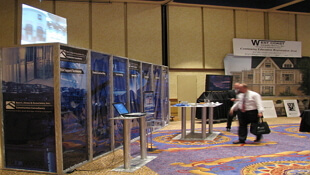
2009-With the success of the rear screen projection, BHA adds additional monitors to provide attendees with more information about BHA.
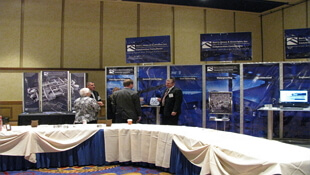
2010-BHA adds an interpretive professional development exhibit targeted to Building Envelope issues allowing adjusters and other non-construction professionals hands on access to the systems and components at the heart of many related such claims.



2011-BHA's Swing for Charity challenge is born.

2012-Always innovating, BHA expands its rear projection and professional development offerings to West Coast attendees.

2013-BHA showcases additional capabilities with a twenty-four foot, custom, convex, immersive video experience.

2014-BHA adds an iPhone display to give a hands-on demonstration of their data collection methods.

2015-BHA's twenty-four foot , custom, convex, immersive video experience was elevated with two additional rear projection screens, reflecting BHA's newest capabilities and services.

2016-BHA dazzles attendees with their new exhibit comprised of more than 15 integrated, high definition, LCD displays. iPads are stationed on tables to conveniently demonstrate BHA's data collection processes.
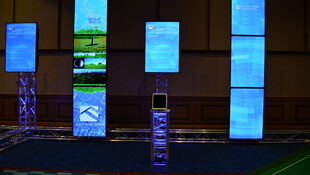
2017-BHA's Swing for Charity Golf Challenge raised $2,225.00 for the National Coalition for Homeless Veterans and $1,900 for Final Salute.
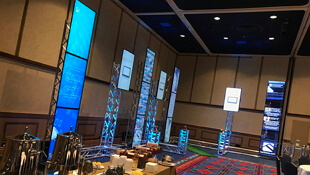
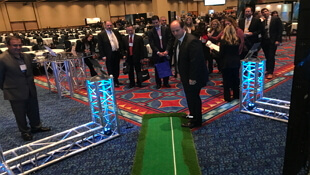
Read the court decisionRead the full story...Reprinted courtesy of
Not If, But When: Newly Enacted Virginia Legislation Bans “Pay-If-Paid” Clauses In Construction Contracts
August 22, 2022 —
Joseph A. Figueroa & Thomas E. Minnis - ConsensusDocsRecently passed legislation in Virginia is likely to dramatically change contractual relationships between prime contractors and subcontractors in the Commonwealth. Abrogating well-established common-law principles set forth by the Supreme Court of Virginia, on April 27, 2022, the Virginia General Assembly, after receiving input from Virginia Governor Glenn Youngkin, passed Senate Bill 550 banning “pay-if-paid” clauses in public and private construction contracts. Contractors performing work in Virginia should take note of the new law, which goes into effect next year and will apply to any contracts executed after January 1, 2023.
The History Of Pay-if-Paid Clauses In Virginia
Broadly speaking, “pay-if-paid” clauses are a commonly used tool by prime contractors on construction projects to shift the risk to subcontractors in the event that the owner does not pay the prime contractor for work. Such clauses usually include language creating an express condition precedent to the subcontractor’s right to be paid for work under a subcontract, stating that the prime contractor shall be under no obligation to pay the subcontractor for work unless and until the prime contractor first receives payment for that work by the project owner. The “pay-if-paid” clause also has a less extreme cousin, the “pay-when-paid” clause, which merely delays the time in which the prime contractor is obligated to pay the subcontractor to the time in which the prime contractor is paid by the owner. It does not, however, extinguish the prime contractor’s ultimate obligation to pay the subcontractor.
Reprinted courtesy of
Joseph A. Figueroa, Watt, Tieder, Hoffar, & Fitzgerald, LLP (ConsensusDocs) and
Thomas E. Minnis, Watt, Tieder, Hoffar, & Fitzgerald, LLP (ConsensusDocs)
Mr. Figueroa may be contacted at jfigueroa@watttieder.com
Read the court decisionRead the full story...Reprinted courtesy of




































































